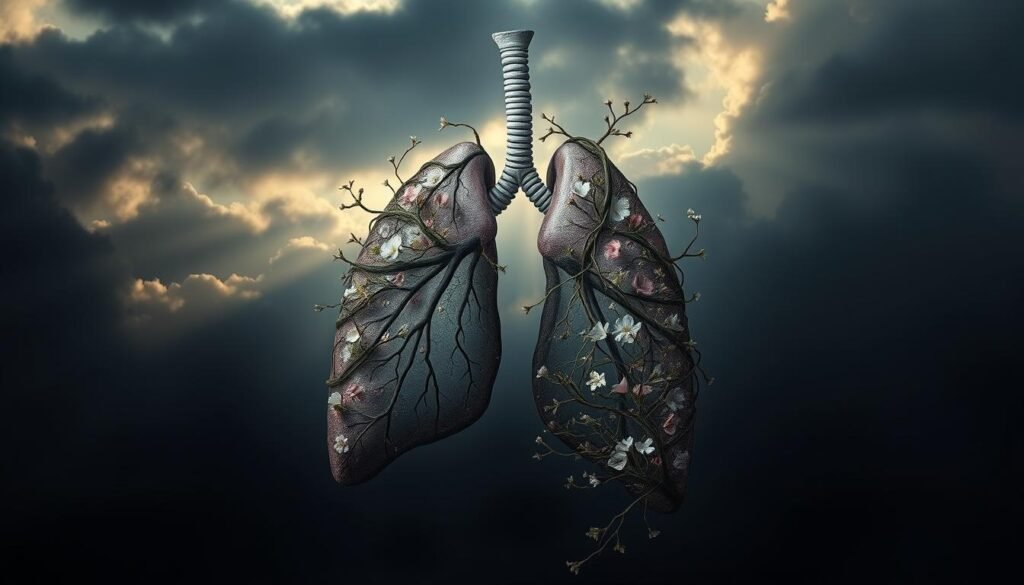Did you know lung cancer makes up 12.2% of all new cancer cases in the U.S.? This significant number shows how serious this illness is, especially when it’s advanced. Knowing the survival rates for stage 4 lung cancer is key. It helps us understand what to expect in terms of prognosis and lifespan. The American Cancer Society uses the SEER database for comprehensive data, giving a detailed view of survival chances.
For those with non-small cell lung cancer (NSCLC), the survival rates are very telling. Only 9% survive 5 years after diagnosis if the cancer has spread to distant organs. But, if the cancer is still localized, the survival rate jumps to 65%. These numbers are crucial. They help evaluate how well treatments work and give important insight to patients and their families. For more stats on lung cancer survival rates, check the American Cancer Society’s resources.
Key Takeaways
- Approximately 12.2% of all new cancer cases in the U.S. are lung cancer.
- Stage 4 NSCLC has a concerning 5-year survival rate of only 9%.
- Survival rates offer critical insights into prognosis and treatment effectiveness.
- Localized lung cancer cases have significantly better survival outcomes compared to those that are metastatic.
- Understanding the factors influencing survival can help patients make informed decisions about their care.
Understanding Lung Cancer
Lung cancer is one of the toughest cancers to beat. It needs thorough understanding for proper diagnosis and treatment. The main types are Non-Small Cell Lung Cancer (NSCLC) and Small Cell Lung Cancer (SCLC). NSCLC makes up about 90% of cases and comes in different forms. SCLC, however, spreads quickly and is very aggressive.
To understand lung cancer, we must know about its stages. The TNM system helps classify the cancer into stages for better treatment plans. The chance of living five years varies by stage. For example, people with locally advanced NSCLC have a 60% chance, but it falls to 9% for distant stage cancer.
Stage 4 lung cancer is split into stages 4a and 4b. Each has its own set of difficulties. Sadly, the median survival for stage 4 patients is about four months. Outcomes can depend on the cancer type and the patient’s health. For NSCLC, the five-year survival rate can be between 13.2% and 20.6%.
Learning all these details is key to understanding treatment and what to expect. If you want more info on lung cancer survival rates, look at these statistics. They show the tough reality patients and their families face.
The Importance of Survival Rates
Understanding the Importance of Survival Rates is key for those dealing with lung cancer. These statistics shed light on Lung Cancer Prognosis. They help in making choices about treatment and care. They are based on past data, offering a glimpse into what might happen.
Lung cancer survival rates depend on the cancer type, stage, and patient health. For example, the 5-year rate for small cell lung cancer (SCLC) is only 3%. For non-small cell lung cancer (NSCLC), it’s a bit better at 9%. These numbers help in understanding how a prognosis might change over time.
When faced with lung cancer, patients look at these rates to think about treatments. For SCLC, the chance of survival is 30% if it hasn’t spread. But it drops to 3% if it has spread far. For NSCLC, the chance is 65% if it’s still in one place, but only 9% if it’s not.
Remember, these numbers are just averages. Every patient’s experience is different, depending on their health and how they respond to treatment. So, while survival rates are important, they should never stop someone from getting personalized advice. Learn more about how these rates are determined.
Survival Rates for Stage 4 Lung Cancer
Understanding survival rates for stage 4 lung cancer shows big challenges. Only about 19% of patients live more than a year after finding out they have it. This stage often has one of the toughest forms of cancer.
Current Statistics and Estimates
A lot of lung cancer cases, especially non-small cell lung cancer (NSCLC), are found late. Around 60% to 70% of NSCLC patients are diagnosed at this late stage. The five-year survival rate is only 7% for NSCLC and 3% for extensive-stage small cell lung cancer (SCLC).
Patients with stage 4 NSCLC usually live only 4 to 9 months after they’re diagnosed. Those with extensive-stage SCLC live around 8 to 13 months. However, some treatments can make a difference. For example, immunotherapy can help patients live up to 15 months longer than chemotherapy. Some patients even live much longer than expected, up to 15 years or more.
Comparisons with Other Lung Cancer Stages
Comparing lung cancer stages shows big differences. The five-year survival rate for early-stage large cell lung cancer can be 61.6%. Early diagnosis really helps improve chances. But, the rates drop a lot by stage 4. The overall five-year survival rate for all lung cancer types at any stage is 26.7%.
It’s very important for patients and families to talk about these numbers with doctors. This helps them make informed choices about treatment and changes in their lives. Knowing about survival rates for advanced lung cancer helps with these tough decisions.
For more details on these numbers and survival rates, check out survival rates for metastatic lung cancer. A full guide is also available at life expectancy with stage 4 lung cancer.
Lung Cancer Prognosis
The outlook for stage 4 lung cancer is a key measure of treatment success and possible results. This stage is advanced lung cancer with a tough challenge ahead. It has a five-year survival rate of only 9%. Factors like a patient’s age, health, and the tumor’s specifics greatly impact these odds.
The survival rates change based on age and health. People under 50 have a five-year survival rate of 14.2%. Those 65 and older have a rate of just 5.6%. Gender matters too; women with advanced lung cancer have an 8.6% survival rate. Men’s rate is lower at 5.6%. These numbers show how crucial the prognosis is and how it differs among patients.
Stage 4 lung cancer has a one-year survival rate of 15% to 19%. Most patients live about four months after diagnosis, which is pretty dire. About 90% of cases are non-small cell lung cancer, guiding treatment choices. Treatments like chemo, surgery, and immunotherapy are personalized. Quitting smoking before chemo may add up to six months to survival times.
For more about stage 4 lung cancer and survival rates, see the statistics here.

Factors Affecting Survival
Stage 4 lung cancer survival rates differ greatly because of many factors. Understanding these can help patients and caregivers as they look at treatment options. Age and overall health are key, affecting how well a patient can handle treatments. Also, the specific type of lung cancer makes a big difference in outcomes. This is because of their unique behaviors. How well a treatment works is also crucial. It can greatly improve how long patients live.
Age and Overall Health
Age and health are very important when looking at Factors Affecting Survival Rates. Older patients may find treatment harder due to other health issues. Younger patients usually have a better chance because they’re generally healthier. Research shows life expectancy varies with different cancer types. For example, patients with squamous cell carcinoma live about 11.5 months on average. Those with adenocarcinoma live a bit longer, around 12.6 months.
Cancer Subtypes and Mutations
The type of Lung Cancer Subtypes matters a lot. Each subtype has its own features that affect how long a patient might live. Adenocarcinoma, the most common NSCLC, often has better survival rates, especially after surgery. Conversely, squamous cell carcinoma usually has poorer outcomes. This info is crucial when planning treatments and setting expectations.
Response to Treatment
How patients respond to Treatment in Lung Cancer greatly affects survival. The success of treatments, like chemo and radiation, can vary a lot. Research shows different survival rates depending on whether the cancer has spread. About 39% of localized cases survive, compared to 44% with distant metastasis. Therefore, better responses to treatment lead to better survival odds.
Terminal Lung Cancer: What to Expect
Those with Terminal Lung Cancer face big hurdles. It’s key to know what to expect. Symptoms like tiredness, pain, and trouble breathing get worse over time. This affects daily life a lot.
Feeling scared, anxious, or sad is common after diagnosis. Knowing this leads to seeking support. Family and friends are crucial for comfort. Mental health experts can also help with coping methods.
Palliative care is very important now. It helps make life better by treating physical and emotional symptoms. There are many ways to help, including pain medicine and emotional support.
The statistics for Terminal Lung Cancer are serious. Only 8% of people with advanced non-small cell lung cancer live five more years. For small cell lung cancer, the rate is even lower at 3%. These facts show how tough it is for patients and their families.
Here’s a quick look at survival rates and treatments:
| Cancer Type | Spread | Five-Year Relative Survival Rate |
|---|---|---|
| Non-Small Cell Lung Cancer (NSCLC) | Distant | 8% |
| Small Cell Lung Cancer (SCLC) | Distant | 3% |
| Non-Small Cell Lung Cancer (NSCLC) | Regional | 37% |
| Small Cell Lung Cancer (SCLC) | Regional | 18% |
Talking in support groups and being open about feelings helps a lot. Facing Terminal Lung Cancer is hard, but strong support makes it easier for patients and families.

Treatment Options for Advanced Non-Small Cell Lung Cancer
When it comes to advanced non-small cell lung cancer (NSCLC), there are a variety of treatment options. The choice of treatment depends on the patient’s health and the specific features of the cancer. For those in stage 4, Treatment for Stage 4 Lung Cancer often includes a mix of therapies. These are designed to improve life quality and increase survival time.
Here are the standard treatments:
- Chemotherapy: This is often given in cycles. A common plan for stage 4 NSCLC might mix drugs like cisplatin or carboplatin with gemcitabine. It’s used at the beginning or when other treatments aren’t working anymore.
- Targeted Therapy: In stage 4 NSCLC, certain gene mutations guide the choice of treatment. Drugs such as osimertinib for EGFR-positive cancers or crizotinib for ALK-positive cancers can be very effective.
- Immunotherapy: This uses the body’s immune system to fight the cancer. Treatments like pembrolizumab and nivolumab work well for NSCLC that don’t have certain mutations, especially if PD-L1 levels are high.
- Surgery: Surgery is rare for stage IV cancers but can help with tumors in certain places like the adrenal glands or brain.
- Radiation Therapy: Radiation can lessen symptoms from metastases or provide care focused on comfort to ease pain.
- Endobronchial Therapies: These less invasive procedures help open up blocked airways caused by tumors.
Crafting a tailored treatment plan involves combining all Advanced Non-Small Cell Lung Cancer Treatment Options. Each therapy not only impacts survival but also how well one lives. Knowing about these treatments allows patients and doctors to collaborate on achieving the best care.
Palliative Care for Lung Cancer
Palliative Care helps lung cancer patients live better. It eases symptoms and stress, no matter the illness stage. It’s not just about treating the disease. It also aims to lessen physical and emotional pain.
Supportive care is key, especially for advanced-stage patients. This includes pain relief, emotional support, and treatments suited to the individual. Professionals like doctors and nurses work together. They help improve the patient’s comfort by managing coughing, breathing issues, and pain.
The following table summarizes key aspects of Palliative Care for Lung Cancer and its impact:
| Aspect | Description |
|---|---|
| Pain Management | Utilizes medications and therapies to alleviate physical pain, improving daily living quality. |
| Emotional Support | Offers counseling and support from mental health professionals to help patients cope with anxiety and depression. |
| Direct Interventions | Includes procedures like bronchoscopy to relieve airway obstructions, enhancing breathing ease. |
| Holistic Approaches | Integrative services such as mindfulness and massage therapy are used to promote relaxation and overall well-being. |
| Communication | Encourages open discussions about goals of care and decisions, helping align treatment with patient values. |
| Locations of Care | Palliative care is available in various settings including hospitals, clinics, and even at home. |
Palliative Care for Lung Cancer is more than end-of-life care. It should start soon after diagnosis. It prioritizes quality of life. This ensures patients get support to face their illness with comfort and dignity.

Emerging Treatments and Clinical Trials
The world of lung cancer treatments is changing fast, offering new options to patients. These include Emerging Lung Cancer Treatments. We also see advanced Therapies for Lung Cancer. Clinical Trials for Stage 4 Lung Cancer provide new insights into effective treatments and medicines.
New treatments target specific genetic mutations like KRAS, EGFR, and ALK. Medicines such as sotorasib (Lumakras™) and adagrasib (Krazati®) are now approved. This marks a big step forward in personalized medicine for lung cancer patients.
It’s crucial to join clinical trials. They offer access to the latest treatments not yet widely available. The CUSTOM trial showed that 54% of participants lived for 21 months or longer. This highlights how trials are key to improving patient survival and life quality.
Therapies like tumor-infiltrating lymphocyte therapy look promising, especially for small cell lung cancer. With ongoing advances, patients have new hopes for better outcomes. These innovative options might outperform traditional treatments.
Conclusion
The journey through stage 4 lung cancer survival rates has given us important insights. In the last five years, the national survival rate has risen to 28.4%, up by 26%. Yet, there’s a big challenge. Only 16.0% of those who should get screened actually do.
This shows a huge chance to catch the disease early. Especially since high-risk groups aren’t getting screened enough. We need to raise awareness and encourage people to take action.
There’s hope in the future of lung cancer research. New treatments and screening methods are being developed. Researchers keep looking into what affects survival rates. Things like a patient’s age, health, and the type of cancer they have.
Genomic diversity and how tumors behave are also key topics. They could lead to treatments that are more tailored to each person. It’s crucial for patients and their families to stay updated and work with their doctors.
This summary shows why it’s so important to be vigilant. Recognizing symptoms and getting screened on time could save lives. With ongoing research, we hope to see better survival rates and lives improved for those facing lung cancer.